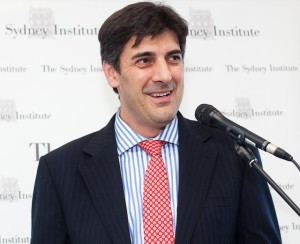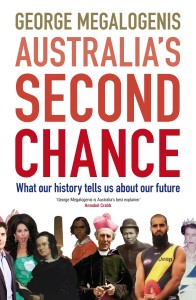Migration places Australia in enviable position
Australia is the first genuine Eurasian nation, according to journalist and author George Megalogenis.
Megalogenis’ new book ‘Australia’s Second Chance: What our history tells us about our future’ charts migration and demographic patterns in Australia and links them to the nation’s economic fortunes.
Megalogenis points to the fact that currently in Australia, 28 per cent of the population was born overseas and 20 per cent has at least one parent born overseas.
“If you look at the two major cities, it’s an even more interesting picture. In Melbourne 35 per cent were born overseas and 24 per cent has an overseas-born parent; and in Sydney those figures are 39 per cent and 25 per cent respectively,” he said.
“So in the two most international of our cities you have 60 per cent of people who, either directly or through their parents, have an idea of how the rest of the world works,” Megalogenis said, speaking at a recent Institute of Public Administration event.
He said that of the 28 per cent of overseas-born people: 10 per cent are from Asia; 9 per cent are from the UK, Ireland, New Zealand or South Africa; 5 per cent are from Europe; and 2 per cent are from the Middle East.
In comparison, just 13 per cent of the people living in the US were born oversees, with 7 per cent coming from Latin America, 4 per cent from Asia and 2 per cent from Europe.
“This puts Australia in the best of all worlds and giving us the potential to make one of the better societies in the 21st Century. We are the first truly Eurasian society,” Megalogenis said.
Despite this rosy outlook, he expressed some words of caution.
“I’m not sure public policy is ready for the population shock that is already underway,” Megalogenis said.
“Australia will hit about 35 million people at mid-century and our cities will get to the size where liveability – something that Australian cities have been recognised for – will become an issue.
“The issue of the size and liveability of cities is expressed in congestion, high crime rates and a breakdown of social cohesion.
“But this for Australia is a challenge from the standpoint of success, not failure,” he said.
Megalogenis says openness to migration and economic success were inextricably entwined.
“Periods in Australia’s history of greatest prosperity are associated with periods of open mass migration,” he said.
“For most of the 19th Century wool and gold were sources of national wealth but the migrants who came were still able to increase our national wealth.
“Australians have a dual personality; we are an open, welcoming and confident people who are globally focused. But we have a second part to us; the chip on the shoulder and the fear of the next set of arrivals.
“We’ve had booms that ran for a generation or two, where we’ve created wealth in the long term. But when the bust comes, we repeat our mistakes.
“From 1830 when free migrants outnumbered convicts for the first time, Australia went off the charts economically, quadrupling the national income over the next 50 years and outstripping even the US economic growth.
“What you had was open borders and the free flow of people and goods,” Megalogenis said.
But between 1891 and 1930 Australia’s national wealth dropped. In 1930, it was 7 per cent lower than it was in 1891.
“When you look at the good times versus the bad times, we’ve repeated our mistakes; we’ve had policies with a short-term focus, we’ve been unduly negative and we’ve seen the dumbing down of public policy debate,” he said
Megalogenis says the economic reconstruction which occurred after WWII came in two phases; first through post-war migration and secondly through the liberalisation of the economy in the 1980s.
“The last 15 years – leaving aside the gold rushes of the 1850s – has been the most extraordinary period in our history in terms of migration,” he said.
“In this latest period we’ve seen the large numbers of migrants from China and India. These are highly motivated and educated people leaving behind countries that are on the rise.
“So, since about 2003 we’ve seen a change in migrants. They are younger, better educated and richer than those who came in the 1980s; they are leaving their countries because of environmental degradation, corruption and over-crowding – to come to paradise.
“We know that migrants contribute 10 to 15 per cent more to the national economy than local born people.
“So one of the questions for public policy will be how do we keep up with these people economically and educationally; and that could ultimately feed into issues around social cohesion,” he said
Megalogenis also said that currently Australia had the highest proportion of migrants from the US since the gold rush.
“For that to be happening means that there is something going on that is globally significant,” he said.
Megalogenis says the dumping of Tony Abbott as Liberal Leader has meant a reset switch has been pressed on public policy debate.
“There is a sense now that we can have serious public policy debates rather than politicians looking for flaws in their opponents,” he said.
He said the trend to news-cycle driven politics had come because of breakdown in relationships between the government and media and the sidelining of the public service.
“The bonds of trust between the government, the public service and the media are now frayed to almost breaking point and the structural shock of this has not passed yet simply with the change of Prime Minister,” Megalogenis said.
He said that over recent decades governments had arrived in power without a decent base of support from the population.
Many state and federal governments had achieved office with something like 40 per cent of the primary vote, Megalogenis said.
“In Labor’s case, Rudd won with 42.1 per cent of the primary vote and Steve Bracks with 45.6 per cent. And the entry primary vote of Daniel Andrews was lower than the exit vote of Joan Kirner,” he said.
“So we’ve seen many governments on both sides of politics take office when 60 per cent of the population didn’t put them number 1.
“The question for now is how will governments get used to conditional mandates to be able to deliver better policy?
“This structural shock is driving up tension and the media is reinforcing the problem. We might now have a new era of policy focus but the structural tensions still exist,” Megolagenis said.
Laurie Nowell
AMES Australia Senior Journalist














